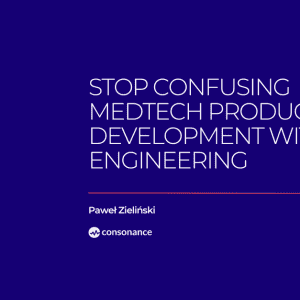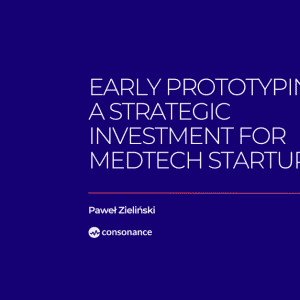Medical device design: smooth transition to production

When launching a medical startup some might have a vision of a medical device design visible on a store shelf. And that’s a good point to kick off. However medical projects are not as fast as lightning and members should think about it as a process that leads from that first perfect image to the certified medical product.
Table of Contents
Let’s take a look on the most common mistakes we observe before even the project has started:
- no investigation of the technologies already available
- poor or no knowledge of the electronics market
- cursory search
- unfamiliarity with the hardware and software development process.
Fortunately, considering the issues below may help to minimise the risk of failure.
How time affects medical device design?
This is the most important factor. There is never enough, and it often goes faster than expected. Moreover, every task takes longer than planned.
Every process is drawn out by many factors – not just the typical mistakes or problems that emerge during device design and/or production, or software development, but also other unexpected events. What we should include to our timeline:
- taking key decisions – how much time we need to move stages forward?
- device certification on the market (MDA, CE, clinical research)
- staff holidays – planned eariler make the project flow more flexible
- time spent waiting for purchased materials to arrive
- choice of suppliers and manufacturers
- logistics – especially now when we are facing semiconductors shortage and dealys in transportation
What you should know more on medical device development?
Risks for MedTech designer
The thing that helps in analysing potential risks is experience which you can get before the project starts. We advise clients to get a TFS – Technical Feasibility Study (or Technical Audit) which should deliver as much answers as possible starting form – is the product possible to build or does it make sense form medical point of view. Professional TFS is a map for anyone involved in a project – from designer and developer, to owner and regulatory specialist. It saves your funds which you can invest in next phases of product development or better product marketing to hit the market succesfully.
More information you get, the better. You can think about an emergency plan which you could base on TFS – alternative solutions to help preserve the usability of the product. Decent knowledge of the technologies and methods used to complete a certain project, as well as experience leading other ventures, helps to determine options and methods to make the idea a reality with greater certainty.
Design
We like good looking devices and medical ones joined that club in recent years. Working simultaneously on both the body and the electronic insides helps in finding a compromise between appearance and functionality. This is very hard to obtain – if not impossible – once one of these processes is completed. Synchronising the work of designers, mechanical engineers and electronic engineers, good communication between them and mutual understanding of the device concept will result in a device that looks good and works sweet as a nut. It may be very functional, work for long periods between recharges or have many innovative functions, and none of that will matter if its appearance and interface would look like it comes form the 80’s.
New ideas
“Let’s add some colour LEDs.” Every engineer has heard at least once similar words as a project was almost finished. In many ventures the first prototype inspires the team members so much that they want to add more features to the device. Often these changes require an additional interface or some free processor pins. It is good to remember during a project’s initial phase when device components are being chosen that such needs may well arise. Limiting resources to a minimum will slow down a product’s evolution. During the next iteration the team will need to recreate the prototype from scratch, and re-using used elements can be time-consuming. This distinguishes hardware development from software development. I will take a risk and claim that it is easier to change a web page components or mobile app rather than the interface of hardware device. It’s simply better to put more effort on the design / ideation stage rather making important changes just before production phase.
Regulations
Only a certified device – especially a medical one – can be brought to the market. During a project, the team must remember to work within the limits described in the regulations and norms for a certain device type. If the whole process begins with preparing the core functionality, to be later adjusted to the requirements, the venture is very likely to fail.
The first approach to the future product should be based on creating several smaller prototypes, each consisting of smaller chunks of the future total functionality. It is easier to redesign a smaller part that does not fit the whole than to start the whole process from the beginning.
Lifetime
Contrary to what one might expect, the electronic components market is very dynamic. When looking at the project lifetime, which often lasts several years, we should also explore the components market. Many of the parts we choose may be entering their end-of-life phase, which may later cause production difficulties (the part will be unavailable and a substitute will be needed). This might not be a problem with passive elements, but a change of chip might be challenging. A different body or interface, or a change in component parameters, will all end up requiring a new design iteration of both hardware and software.
Hope this short article will help you to avoid some project obstacles. If you’d like to discuss your next medical project just write to us: office@consonance.tech






